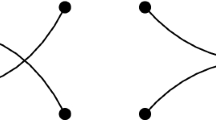This paper begins with a review of the Euler relation for the polyhedra and presents the corresponding Schläfli relation in n, the polygonality, and p, the connectivity of the polyhedra. The use of ordered pairs as given by (n, p), the Schläfli symbols, to organize the mapping of the polyhedra and its extension into the two dimensional (2D) and three dimensional (3D) networks is described. The topological form index, represented by l, is introduced and is defined as the ratio of the polygonality, n, to the connectivity, p, in a structure, it is given by l = n/p. Next a discussion is given of establishing a conventional metric of length in order to compare topological properties of the polyhedra and networks in 2D and 3D. A fundamental structural metric is assumed for the polyhedra. The metric for the polyhedra is, in turn, used to establish a metric for tilings in the Euclidean plane. The metrics for the polyhedra and 2D plane are used to establish a metric for networks in 3D. Once the metrics have been established, a conjecture is introduced, based upon the metrics assumed, that the area of the elementary polygonal circuit in the polyhedra and 2D and 3D networks is proportional to a function of the topological form index, l, for these structures. Data of the form indexes and the corresponding elementary polygonal circuit areas, for a selection of polyhedra and 2D and 3D networks is tabulated, and the results of a least squares regression analysis of the data plotted in a Cartesian space are reported. From the regression analysis it is seen that a quadratic in l, the form index, successfully correlates with the corresponding elementary polygonal circuit area data of the polyhedra and 2D and 3D networks. A brief discussion of the evident rigorousness of the Schläfli indexes (n, p) over all the polyhedra and 2D and 3D networks, based upon the correlation of the topological form index with elementary polygonal circuit area in these structures, and the suggestion that an Euler-Schläfli relation for the 2D and 3D networks, is possible, in terms of the Schläfli indexes, concludes the paper.
Similar content being viewed by others
References
Elementa doctrinae solidorum et Demonstratio nonnularum insignium proprietatum quibus solida heddris planis inclusa sunt praedita, L. Euler, included in the Proceedings of the St. Petersburg Academy, 1758.
(a) M. Henle, A Combinatorial Introduction to Topology, 1st edn. (W.H. Freeman and Company, San Francisco, CA, 1979). (b) A.F. Wells, Three Dimensional Nets and Polyhedra, 1st edn. (Wiley and Sons Inc., New York, 1977).
A.F. Wells, The geometrical basis of crystal chemistry: (a) Part 1, A.F. Wells Acta Cryst. 7 (1954) 535. (b) Part 2, A.F. Wells Acta Cryst. 7 (1954) 545. (c) Part 3, A.F. Wells Acta Cryst. 7 (1954) 842. (d) Part 4, A.F. Wells, Acta Cryst. 7 (1954) 849. (e) Part 5, A.F. Wells, Acta Cryst. 8 (1955) 32. (f) Part 6, A.F. Wells, Acta Cryst. 9 (1956) 23. (g) Part 7, Wells, A.F. and R.R. Sharpe, Acta Cryst. 16 (1963) 857. (h) Part 8, A.F. Wells Acta Cryst. 18 (1965) 894. (i) Part 9, A.F. Wells, Acta Cryst. B24 (1968) 50. (j) Part 10, A.F. Wells, Acta Cryst. B25 (1969) 1711. (k) Part 11, A.F. Wells Acta Cryst. B28 (1972) 711. (l) Part 12, A.F. Wells, Acta Cryst. B32 (1976) 2619. (m) A.F. Wells, Three Dimensional Nets and Polyhedra, 1st edn (Wiley and Sons Inc., New York, 1977). (n) A.F. Wells, Further Studies of Three-dimensional Nets, American Crystallographic Association, Monograph Number 8, 1st edn (American Crystallographic Association Press, PA 1979). Note that unfortunately the author could not locate direct references to the work of Schläfli in topology, the references to Wells are indirect but refer to Schläfli’s work.
(a) M. Wenninger, Dual Models, 1st edn (Cambridge University Press, Cambridge, 1983). (b) P.J. Frederico, Descartes on Polyhedra: A Study of the De Solidorum Elementis, Sources in the History of Mathematics and Physical Sciences 4, 1st edn (Springer-Verlag, Berlin 1982).
Bucknum M.J. (1997). Carbon 35(1): 1
A.F. Wells, Further Studies of Three-dimensional Nets, American Crystallographic Association, Monograph Number 8, 1st edn (American Crystallographic Association Press, Pittsburgh, PA, 1979).
The Wells fundamental polyhedra metric, the Wells structural correspondence principle and the Wells morphological principle, all 3 used in this paper to derive the polyhedral and 2D and 3D metrics, and to determine the data in table 1; and the Wells coincidences and the Wells conjecture, which emerge as a consequence of the data in table 1; have been collectively named to honor Professor A.F. Wells who was at the University of Connecticut, Storrs for some years, where he established himself as a master of applied topology and derived more than 100 novel networks.
Müller U. (1992). Inorganic Structural Chemistry, 2nd edn. Wiley and Sons Inc., New York
Pauling L. (1989). The Nature of the Chemical Bond, 3rd edn. Cornell University Press, Ithaca, NY
Bannister F.A. (1937) Zeit. f. Krist. 96: 201
(a) E.E. Galloni and A.E. Roffo, J. Chem. Phys. 9 (1941) 875. (b) J. Waser and E.D. McClanahan, J. Chem. Phys. 19 (1951) 413.
(a) M.J. Bucknum, Chem. Preprint Arch 2001(1) (2001) 28. (b) M.J. Bucknum and E.A. Castro, J. Math. Chem. in press (2006).
M.J. Bucknum and E.A. Castro, Commun. Math. Comput. Chem. (MATCH). 54 (2005) 89.
Author information
Authors and Affiliations
Corresponding author
Additional information
This paper is a republication with extensive corrections to the original manuscript which appeared in January 2006, Volume 39, No. 1, pp. 33–46.
Rights and permissions
About this article
Cite this article
Bucknum, M.J., Castro, E.A. On topological form in structures. J Math Chem 40, 327–340 (2006). https://doi.org/10.1007/s10910-006-9160-3
Received:
Revised:
Published:
Issue Date:
DOI: https://doi.org/10.1007/s10910-006-9160-3




